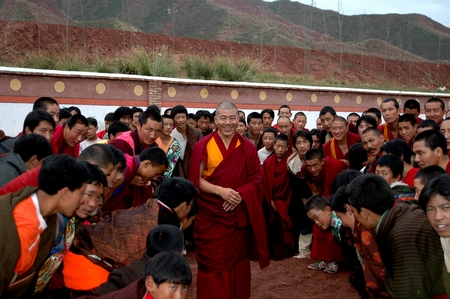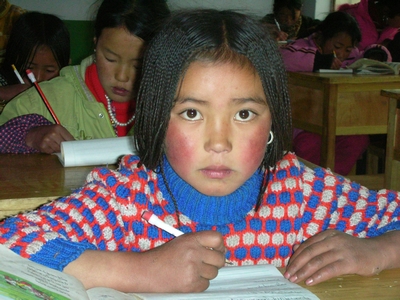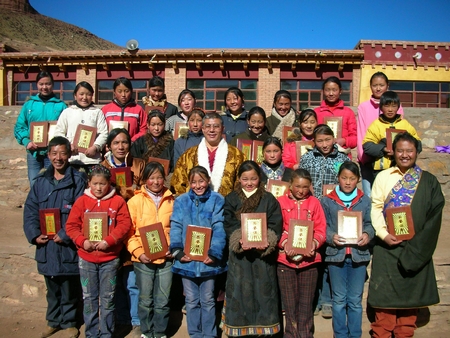Life
Teacher nonpareil
By Liu Zhihua (China Daily)
Updated: 2010-08-26 13:43
 |
Large Medium Small |

Jigme Gyaltsen with his male students at the school he established in 1994 in Guoluo Tibetan autonomous prefecture, Qinghai province. Photos provided to China Daily |
A Tibetan monk founds a school for the poor children of herdsmen and lamas after experiencing the hardships of education himself. Liu Zhihua reports
If a Tibetan monk is a leader, he is usually head of a monastery. If he's a teacher, he will generally give classes to monks on Tibet's religion and traditional culture. Jigme Gyaltsen is different. He's the principal of a school for monks and civilian students that teaches not only Tibetan languages and the region's classics, but also science and technology.
A school dropout from a poor family, Jigme turned his life around after becoming a monk and in 1994 established Jigme Gyaltsen Welfare School in Guoluo Tibetan autonomous prefecture, Qinghai province.
"It's a teacher's heaven," says Huang Chun, a teacher at the prestigious Beijing No 4 high school after visiting the school in June.
"Students are thirsty for knowledge, they regard teachers as a light in the darkness and respect them. Relationships between students and teachers are both equal and harmonious."
The school on Ani Gongqun Mountain is for the impoverished children of herdsmen and lamas on the Qinghai-Tibet Plateau and has become one of the most popular schools in the area.
In early September, many herdsmen and Tibetan monks will rush to put their own names or those of their children on the shortlist for admission.
"I enroll about 150 students annually," the red-robed Jigme says, "but receive more than 1,000 applications every year."
He established the school with 130,000 yuan ($19,120), which comprised his life savings and donations from both wealthy businessmen and living Buddhas in the region. He started with 86 students and two teachers, including himself. Currently, there are 782 students in six grades.
"We would have hundreds more students if we had enough money to support them," Jigme says.
The monk does not charge tuition fees and gives free lodging and meals to poor students.
Donations to the school are all spent on students. Teachers were not even paid until last year when a Beijing businessman made a substantial donation, on condition the money was spent on teachers' salaries.
There are no age requirements for students, who are divided into six grades according to competency. The youngest child at the school is 6 years old, while the oldest is 42.
"It is good to let them live and learn together; they will discuss things freely and be inspired to learn more," the lama says.
Adopting Buddhist logic he has created a new way of teaching. Every day, students spend 30 minutes at noon and 40 minutes in the afternoon debating with classmates and teachers their newly acquired knowledge.
Jigme claims that after six years of classes his graduates generally have an education level equivalent to high school, and some of them can compete with post-graduate students when it comes to studying the Tibetan language.
A total of 126 temples have sent their monks to his school, and a number of young living Buddhas, or high-ranking lamas, have asked to be admitted.
Jigme is revered on the Qinghai-Tibet Plateau as a reformer of education.

A Tibetan student at the Jigme Gyaltsen Welfare School for girls. |

Award-winning students pose with their proud teacher. |
He was born into a poor rural household on the east Qinghai-Tibet Plateau, in 1965. He knows firsthand how difficult it is for rural kids to get an education.
"I got the idea of building such a school from my personal experience," the monk says.
Free public schools on the sparsely populated plateau are always in towns and too far away for rural children to commute to. Therefore, if a child is studying far away this means he will not be able to work and in addition his accommodation costs will be a burden on the family.
While for the boys from impoverished herdsmen living on the plateau, joining monasteries are a way to receive free education and lodging, there are few options for the girls.
It was to cater to this group that Jigme established a branch of his school exclusively for girls. It now has 400 students.
Talking of his early life Jigme says he was fortunate that his parents decided to move from a remote area to the center of Dawu town, in Guoluo, and aged 10 he enrolled at the primary school.
"I was excited to learn," Jigme says.
His family, which earned a living herding some sheep and yaks on borrowed pasture and sold yak dung at 0.15 yuan (2 cents) a bag could not afford his studies after 1983, when he was at a college school in Xining, capital of Qinghai province.
He therefore became a monk at Ta'er Monastery near Xining in order to continue his studies and was later sent to Lanbrang Monastery for two years.
In 1986, he was admitted to Qinghai Institute of Buddhism. Three years later, he graduated to the China Tibetan Language High Institute of Buddhism in Beijing.
He received a systemic education in Tibetan Buddhism philosophy and traditional Tibetan culture and became a lama. Later, he passed an examination to become a geshe, which is the Buddhist monk's equivalent to a PhD.
After graduating he returned to Qinghai. It was while studying at the monastery that he started thinking about the way forward for education.
"The best way, I figured, is too combine the public school model with the monastery model," he says.
At his school, Tibetan, English and Chinese languages are required courses for the first three grades, and Tibetan medicine, thangka painting and computer skills are optional majors for students in the last three years.
"Learning in secluded monasteries gives one no sense of modern technology and culture, while public schools offer insufficient traditional culture training. We need a balanced education," Jigme says.